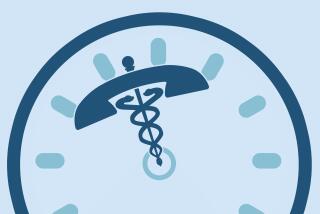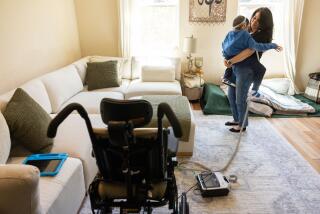HIV Patients Lack Services, Study Finds
- Share via
PANORAMA CITY — The first in-depth study of HIV-positive patients treated at government-funded clinics in the San Fernando and Antelope valleys reveals that most are getting quality medical care, but a majority lack stable housing, much-needed mental health services and transportation to medical appointments.
The survey, whose findings are being released today, was conducted by the Van Nuys-based Survey Research Services Inc. It interviewed 310 HIV-positive people receiving services at 15 public agencies in the two areas.
According to the findings, the vast majority were indigent patients with no medical insurance, as is the case with the majority of HIV-infected patients in Los Angeles County.
“HIV has always been a poverty-linked disease,” said sociologist Judith Mayo, who supervised the study. The survey’s purpose was to gather information on patient needs beyond medical care to determine how to provide those services.
“We need to get people access to things like mental health [care], housing and transportation as much as medical services,” said Mayo, who is overseeing a five-year plan to coordinate those services.
The project, called HIV Cybermall, received nearly $1 million in federal funding from the Ryan White Care Act, which annually provides millions of dollars in grants for the care, counseling and support of people with AIDS or HIV.
The survey’s findings that patients need more than medical care confirm what HIV experts have believed for years, said Mark Henrickson, director of the HIV division of the Northeast Valley Health Corp., which operates the Panorama City HIV clinic. The clinic is the largest HIV outpatient center in the San Fernando Valley--serving 450 patients, 98% of whom live in poverty--and was the lead agency in the nine-month survey.
Soon after Henrickson, who has a doctorate in sociology from UCLA, came to the clinic three years ago, he said he realized the need for data that focused specifically on the San Fernando, Santa Clarita and Antelope valleys.
Henrickson said there are many misconceptions about HIV in Los Angeles County, and the data provided by the new study can help dispel many.
“When people want to do stories on HIV, where do they go? West Hollywood,” he said. “When people want to get services, where do they go? West Hollywood. There are a lot of services out here in the Valley and a lot of people infected with HIV.”
*
According to the Los Angeles County Department of Health Services, an estimated 40,000 HIV-positive people live in the county, and about 5,860 of them are in the tri-valley area.
Henrickson estimates only 1,000 of those are receiving medical care.
“There’s a whole lot of folks not getting care, and hopefully with better services that could change,” Henrickson said. “This [survey] is a good first step.”
The study organized the data by ethnicity, age, sexual orientation and education levels.
The findings show that 42.3% of Valley HIV patients are white, 30.2% Latino and 20% African American. About 43% are gay; 45% have not graduated from high school.
Nearly 44% of the patients are 36 to 45, and nearly 82% speak English as their primary language. More than half of the patients surveyed have been in jail or have a history of substance abuse, and the median annual income is $7,800.
“This is extraordinary data, because this is a group that providers think of as hard to serve,” Mayo said. “These people are dealing with very serious life problems. Some don’t even have a refrigerator to keep their medication.”
Yet most are regularly visiting their doctors, and a majority are on new drug therapies, Mayo said.
The next step is finding ways to provide transportation, financial aid and help in locating stable housing for these patients.
Also in the works is a computer Web site that will include information on how and where to get all types of HIV-related services in the tri-valley area and link to other county and national information sources.
Computers will be available at the clinics to give patients and staff access to the information.
“There’s a concept that most people infected with HIV are downtown, but they’re in the Valley too, and we need to serve them,” Henrickson said.






